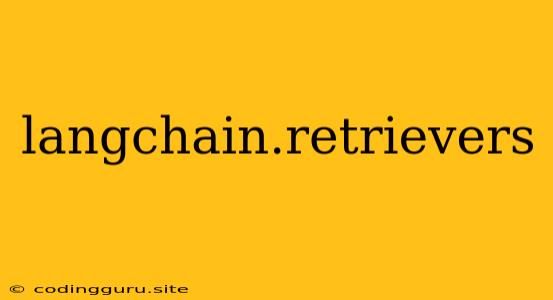Exploring the Power of LangChain Retrievers: Unlocking the Potential of Your Data
In the realm of large language models (LLMs), accessing and utilizing relevant information is paramount. LangChain Retrievers emerge as a powerful tool to bridge this gap, enabling LLMs to effectively tap into vast stores of data and extract the most pertinent information for a given query.
But what exactly are LangChain Retrievers?
At its core, LangChain is a framework designed to connect LLMs with external data sources. Retrievers, a key component within LangChain, act as information gatherers, responsible for retrieving relevant data from these external sources. These sources can range from simple text files and databases to more complex knowledge bases and APIs.
Why are LangChain Retrievers so important?
Imagine you have a chatbot that needs to answer questions about a company's products. Without LangChain Retrievers, the chatbot would rely solely on its internal knowledge base, which might be limited. Retrievers empower the chatbot to access the company's website, product manuals, and customer reviews to provide comprehensive and accurate answers.
Let's delve deeper into the world of LangChain Retrievers:
Types of LangChain Retrievers:
LangChain offers a wide range of retrievers, each suited for specific data sources and retrieval strategies:
- Document Retrievers: These retrievers target unstructured data like text files, PDFs, and web pages.
- SimpleFileSystemRetriever: Scans files within a specified directory for relevant content.
- WikipediaRetriever: Retrieves information directly from Wikipedia pages.
- AzureCognitiveSearchRetriever: Leverages Azure Cognitive Search for efficient data retrieval.
- Database Retrievers: Retrievers designed for structured data residing in databases.
- SQLDatabaseRetriever: Allows queries using SQL for extracting data from relational databases.
- MongoDBRetriever: Accesses data stored in MongoDB databases.
- API Retrievers: Utilize APIs to access external data sources.
- OpenAIEmbeddingsRetriever: Integrates with OpenAI's embedding model for semantic search.
- GoogleSearchRetriever: Retrieves results directly from Google Search.
How do LangChain Retrievers Work?
Retrievers utilize different techniques to identify and retrieve relevant information:
- Keyword-based Retrieval: Retrievers look for exact matches or close variations of keywords in the query.
- Semantic Search: Retrievers use embeddings to understand the meaning of the query and retrieve documents based on semantic similarity.
- Vector Search: Retrievers create vector representations of both queries and data points, enabling efficient similarity-based retrieval.
Integrating LangChain Retrievers with LLMs:
Once you've chosen the appropriate retriever, you can seamlessly integrate it with your LLM:
- Connect the Retriever: Establish a connection between the retriever and your LLM using LangChain's framework.
- Query the Retriever: Submit your query to the retriever, which will access the external data source.
- Retrieve Relevant Information: The retriever will return the most relevant data based on your query.
- Pass Information to LLM: Feed the retrieved information to your LLM, allowing it to leverage the context for more informed and accurate responses.
Example: Building a Chatbot with LangChain Retrievers
Imagine you want to create a chatbot that can answer questions about a company's products. You can leverage LangChain Retrievers to access the company's product database and website.
Here's how you could implement it:
- Set up the Retriever: Utilize a SQLDatabaseRetriever to connect to the company's product database.
- Query the Database: When a user asks a question about a specific product, the chatbot can query the database using the SQLDatabaseRetriever.
- Retrieve Product Information: The retriever will extract relevant product details from the database.
- Augment with Website Information: To provide more comprehensive information, you can use a SimpleFileSystemRetriever to access the company's website and retrieve additional product details.
- Pass Information to LLM: The retrieved information from both sources is passed to the LLM, enabling the chatbot to provide a detailed and informative answer.
Benefits of Using LangChain Retrievers:
- Enhanced Information Access: LLMs can access a wider range of data sources, leading to more informed responses.
- Improved Accuracy: Retrievers ensure that the LLM receives the most relevant information, resulting in more accurate answers.
- Faster Retrieval: Retrievers utilize efficient search techniques to retrieve information quickly.
- Flexibility and Scalability: LangChain offers a variety of retrievers, making it easy to adapt to different data sources and retrieval needs.
Conclusion
LangChain Retrievers are an indispensable tool for unlocking the full potential of LLMs by enabling them to leverage external data sources. By seamlessly integrating retrievers into your LLM applications, you can significantly enhance information access, accuracy, and efficiency. From simple text files to complex databases and APIs, LangChain Retrievers offer a flexible and powerful way to access and utilize the vast resources available to your LLMs.
